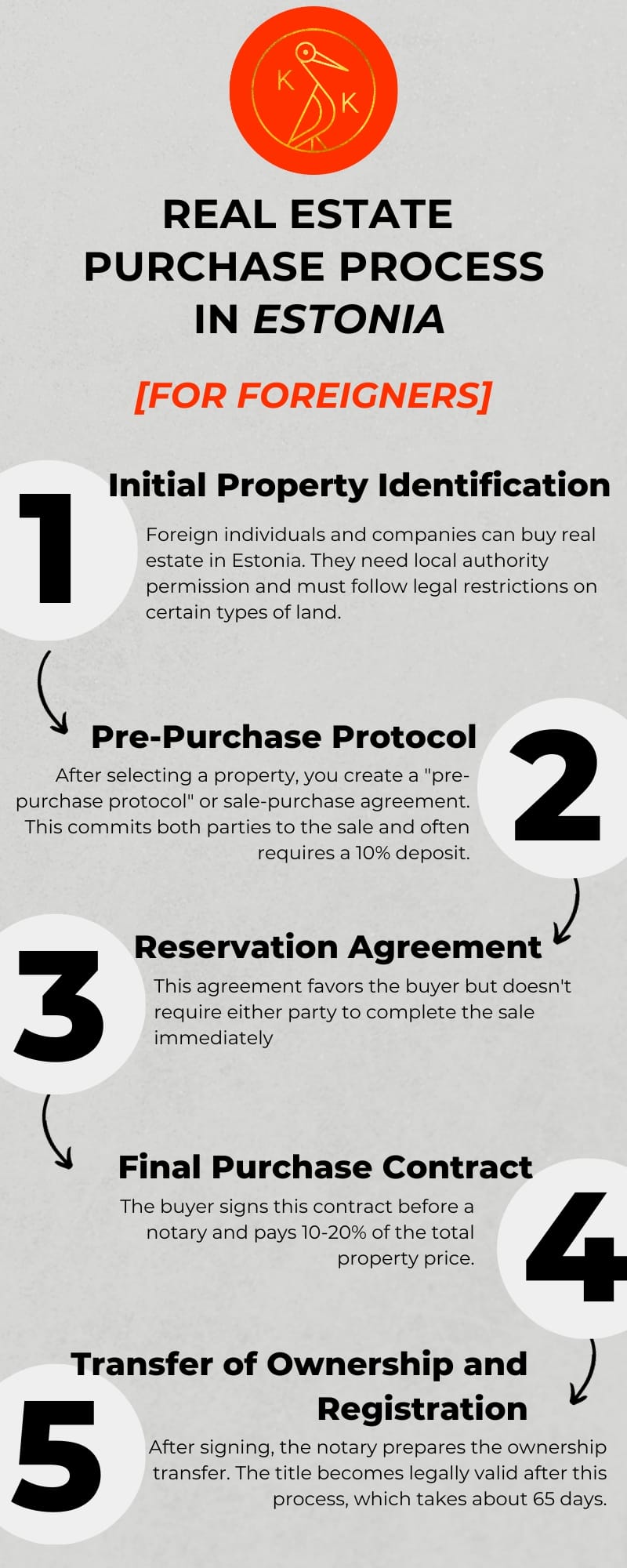Estonia, a gem in the Baltic region, offers a unique real estate market that has increasingly attracted foreign investors looking to understand how to buy property in Estonia.
This guide gives a detailed overview of how to buy a house or apartment in Estonia. We discuss the necessary legal steps and provide valuable insights into Estonia’s housing market.
Estonia provides diverse housing options, whether you seek a cozy home in the historic city center or a modern apartment in a newer district.

Understanding Estonian Real Estate Law
Legal Considerations for Foreign Buyers
Estonia offers a welcoming environment for foreign real estate investors with similar property purchasing rights as Estonian citizens.
However, certain restrictions apply. Non-European Union foreigners face limitations when purchasing properties on specific Estonian islands.
Some examples include:
- Saaremaa
- Hiiumaa
- Vormsi
- Muhu
They are also limited to purchasing no more than 10 hectares of forest or agricultural land.
The Estonian legal process for purchasing real estate is relatively straightforward. It requires local authorities’ permission in specific cases. For example, it is acquiring large agricultural or woodland areas.
Restrictions prevent foreigners from owning land in the smaller islands or areas near the Russian border.
Property Ownership Types in Estonia
In Estonia, if real estate properties are not on the Land Register, people consider them movable properties.
- Private Ownership (Eraomand): Full control, rights to use, lease, sell, or inherit property.
- Public Ownership (Avalik omand): Properties owned by the government or public entities for public use.
- Cooperative Ownership (Ühistuomand): Joint ownership, often seen in housing cooperatives.
- Leasehold Ownership (Üürimisomand): Right to use property for a specified period without owning the land.
- Estate Ownership (Mõisomand): Historical ownership, large land estates, less common today.
- Common Ownership (Ühine omand): Joint ownership with shared rights and responsibilities.
- Condominium Ownership (Korteriomand): Ownership of individual units in an apartment building with shared common areas.
These ownership types come with specific legal rules and financial obligations, so it’s important to understand them when dealing with property in Estonia.
This shows why it’s so important to register them. Ensure you register the property when making your purchase decision.
Inspecting for encumbrances, such as mortgages, is crucial. You must also verify that the current owner has no outstanding debts with the authorities.
Websites that help you check the necessary information on how to buy property in Estonia
The e-Land Register
When considering property in Estonia, ensure you’re well informed about the details of the real estate you’re interested in. The e-Land Register is a valuable resource, providing easy access to comprehensive information about immovable assets.

This resource offers various essential details, such as:
- Property details include the address, type, and historical information that might affect your decision.
- Size: You will discover precise measurements to determine if it suits your needs.
- Ownership info: Knowing the current owner is essential for transparency.
- Restrictions: Be aware of any limitations on using the property.
- Mortgages: Check for existing loans for financial planning and negotiations.
This website offers insights into the Land Register in Estonia, detailing real estate ownership and property encumbrances.
You get a reservation contract. This gives priority to the buyer and specifies the sale terms and any deposits paid.
You must sign the final purchase contract before a public notary. More information about notaries in Estonia can be found at Notaritekoda.
Real Estate Databases of Estonia
The Baltic Legal Law website offers comprehensive guidance about the Estonian Land Register. This includes information on property encumbrances, an essential resource for due diligence.
Additionally
In Estonia, legally transferring property ownership doesn’t involve property deeds. Instead, you make a notarized application to the Land Register. Once you complete this process, the property title becomes legally valid.
The entire process of registering property in Estonia averages around 65 days, indicating a streamlined and efficient system.
This overview offers insight into the legal steps and process for foreigners buying property in Estonia. It also highlights the available opportunities and critical factors that need consideration.
Navigating the Estonian Real Estate Market
Identifying Prime Locations for Investment
Estonia’s property market provides diverse opportunities across various regions. According to 2018-2019 data, there are vital distinctions:
- In prime investment areas, new city apartments cost between €2300 and €5000 per square meter.
- In contrast, apartments in residential districts are typically priced between €1500 and €2200 per square meter.

These price differences result from various factors, including:
- The specific location of the property.
- Reach amenities like public transportation or shopping areas.
These factors highlight the importance of choosing the best location to invest in Estonia’s real estate market.
Working with Real Estate Agents in Estonia
When buying property in Estonia, working with real estate agents is helpful. Here are some key points in simple terms:
- You need a notarized agreement to buy real estate. This involves notary and state fees.
- The buyer and seller usually share these costs. A real estate broker often helps you with them.
- You and the seller will sign a booking or reservation agreement. This agreement ensures the seller will not market the property to others for a certain period.
- This gives you time to get your finances ready.
- Notary fees in Estonia depend on the property’s value.
- Additionally, these fees include a 20% VAT (Value Added Tax).
Steps for Foreigners Buying Property in Estonia
Steps in the Property Buying Process
- Initial Property Identification
Foreign individuals and companies can buy real estate in Estonia. They need local authority permission and must follow legal restrictions on certain types of land.
- Pre-Purchase Protocol
After selecting a property, you create a “pre-purchase protocol” or sale-purchase agreement. This commits both parties to the sale and often requires a 10% deposit.
- Reservation Agreement
This agreement favors the buyer but doesn’t require either party to complete the sale immediately. If you don’t finalize the agreement immediately, a notary public will oversee the signing of a pre-purchase contract.
- Final Purchase Contract
The buyer signs this contract before a notary and pays 10-20% of the total property price.
- Transfer of Ownership and Registration
After signing, the notary prepares the ownership transfer. The buyer pays the stamp duty, followed by a notarized application to the Land Register.

Financial Considerations
- Notary and Stamp Duty Fees: Parties must agree on who will pay the notary fee and the property purchase amount. The buyer pays stamp duty at a commercial bank before registration.
- Additional Costs include realtor fees (2% – 4% paid by the seller), notary fees, and applicable VAT.
- Understanding these steps and financial requirements is crucial for smooth property acquisition in Estonia.
Additional Considerations for Foreign Buyers
Residency and Legal Status
Purchasing property in Estonia doesn’t automatically grant residency rights. However, owning property can be a part of the relocation process.
Owning property can be advantageous if you consider applying for a temporary residence permit. Understanding the available permit types, entry requirements, required documentation, and current fees is crucial.
The Estonian Ministry of the Interior imposes specific requirements and conditions on property ownership and residency. Understanding these requirements and conditions is vital when considering a property purchase as part of your relocation.

Long-term Investment Potential in Estonia
Estonia’s resilient and growing real estate market makes it an attractive choice for long-term investments. The country’s stable economy, coupled with a growing demand for real estate, provides a solid foundation for investment.
As an investor, it’s essential to think about the potential returns, like
- rental income
- property value growth
When making investment decisions, consider the real estate market’s changes, such as development trends and urban planning.
Kurg & Korsten Real-Estate Agency Can Help You
Ready to explore the Estonian real estate market? Navigating the nuances of property purchases in a foreign country can be overwhelming.
This is where Kurg & Korsten Real Estate Agency can make a significant difference. We offer expert guidance and personalized assistance thanks to our knowledge of Estonian real estate, legalities, and market trends.
To invest or find a home in Estonia, we’re here to help you at every step.
Contact Kurg & Korsten today and take the first step towards making your investment dream a reality.





